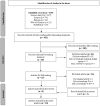Food insecurity and its socioeconomic and health determinants in pregnant women and mothers of children under 2 years of age, during the COVID-19 pandemic: A systematic review and meta-analysis
- PMID: 36761119
- PMCID: PMC9902714
- DOI: 10.3389/fpubh.2023.1087955
Food insecurity and its socioeconomic and health determinants in pregnant women and mothers of children under 2 years of age, during the COVID-19 pandemic: A systematic review and meta-analysis
Abstract
Background: The COVID-19 pandemic has reduced access to adequate food in terms of quality and quantity, especially for the most vulnerable population groups. The objective of this study was to evaluate the prevalence of Food Insecurity and its main socioeconomic and health determinants in pregnant women and mothers of children under 2 years of age, during the COVID-19 pandemic.
Methods: This systematic review was conducted in accordance with the Preferred Reporting Items for Systematic Reviews and Meta-analyses (PRISMA) and registered in the International Prospective Register of Systematic Reviews (PROSPERO) (CRD42021278033). The descriptors "Pregnant Woman", "Postpartum Women", "Breastfeeding Women", "COVID-19", "Food Insecurity", "Food Security" were combined in Scopus (Elsevier), Medline/PubMed (via National Library of Medicine), Embase (Elsevier), Web of Science and Science Direct independently by two researchers in September 2022. Original articles about Food Insecurity in households with pregnant women and mothers of children under 2 years of age during the COVID-19 pandemic were included. The meta-analysis of the prevalence of Food Insecurity was conducted using the RStudio software (4.0.4).
Results: The initial search resulted in 539 records, and 10 articles met the proposed criteria and were included in this review. The prevalence of Food Insecurity ranged from 11.5 to 80.3% and in the meta-analysis it was 51% (IC: 30-71) (I 2 = 100.0%). The main socioeconomic and health determinants were ethnicity, domain language, low education, low income, informal employment, unemployment, occurrence of mental disorders, domestic violence, in addition to the unavailability of food in markets and lack of transport. The inclusion of studies with data collection by telephone stands out as a limitation, due to the non-inclusion of vulnerable groups without access to this means of communication.
Conclusion: It is necessary to implement and strengthen specific public policies for the maternal and child group with the objective of protecting and strengthening the rights of women to maintain the physical and mental integrity of this group and guarantee Food Security.
Keywords: SARS-CoV-2; food security; postpartum period; pregnancy; social determinants of health.
Copyright © 2023 Azevedo, Morais, Silva, Candido, Morais, Priore and Franceschini.
Conflict of interest statement
The authors declare that the research was conducted in the absence of any commercial or financial relationships that could be construed as a potential conflict of interest.
Figures




References
-
- WHO . Coronavirus Disease 2019 (COVID-19) Situation Report—46 (2020). Available online at: https://www.who.int/docs/default-source/coronaviruse/situation-reports/2... (accessed October 15, 2021).
-
- FAO . The State of Food Security and Nutrition in the World 2021 (2021). Washington, DC: FAO, IFAD, UNICEF, WFP, WHO, editors.
-
- Cardoso DF, Domingues E, Magalhães A, Simonato T, Miyajima D. Pandemia de COVID-19 e famílias: impactos da crise e da renda básica emergencial. In: Nota de Política Social 2. Políticas Sociais: acompanhamento e análise (BPS). Instituto de Pesquisa Econômica Aplicada (Ipea) (2021). p. 28.
Publication types
MeSH terms
LinkOut - more resources
Full Text Sources
Medical
Miscellaneous

